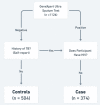This is a preprint.
Strong Effect of Demographic Changes on Tuberculosis Susceptibility in South Africa
- PMID: 37961495
- PMCID: PMC10635255
- DOI: 10.1101/2023.11.02.23297990
Strong Effect of Demographic Changes on Tuberculosis Susceptibility in South Africa
Update in
-
Strong effect of demographic changes on Tuberculosis susceptibility in South Africa.PLOS Glob Public Health. 2024 Jul 23;4(7):e0002643. doi: 10.1371/journal.pgph.0002643. eCollection 2024. PLOS Glob Public Health. 2024. PMID: 39042651 Free PMC article.
Abstract
South Africa is among the world's top eight TB burden countries, and despite a focus on HIV-TB co-infection, most of the population living with TB are not HIV co-infected. The disease is endemic across the country with 80-90% exposure by adulthood. We investigated epidemiological risk factors for tuberculosis (TB) in the Northern Cape Province, South Africa: an understudied TB endemic region with extreme TB incidence (645/100,000) and the lowest provincial population density. We leveraged the population's high TB incidence and community transmission to design a case-control study with population-based controls, reflecting similar mechanisms of exposure between the groups. We recruited 1,126 participants with suspected TB from 12 community health clinics, and generated a cohort of 878 individuals (cases =374, controls =504) after implementing our enrollment criteria. All participants were GeneXpert Ultra tested for active TB by a local clinic. We assessed important risk factors for active TB using logistic regression and random forest modeling. Additionally, a subset of individuals were genotyped to determine genome-wide ancestry components. Male gender had the strongest effect on TB risk (OR: 2.87 [95% CI: 2.1-3.8]); smoking and alcohol consumption did not significantly increase TB risk. We identified two interactions: age by socioeconomic status (SES) and birthplace by residence locality on TB risk (OR = 3.05, p = 0.016) - where rural birthplace but town residence was the highest risk category. Finally, participants had a majority Khoe-San ancestry, typically greater than 50%. Epidemiological risk factors for this cohort differ from other global populations. The significant interaction effects reflect rapid changes in SES and mobility over recent generations and strongly impact TB risk in the Northern Cape of South Africa. Our models show that such risk factors combined explain 16% of the variance (r2) in case/control status.
Conflict of interest statement
Conflicts of Interest All authors declare no conflict of interest.
Figures





References
-
- WHO. Global Tuberculosis Report 2021 [Internet]. 2021. Oct [cited 2022 Aug 8]. Available from: https://www.who.int/publications/i/item/9789240037021
-
- Sharma SK, Mohan A. Extrapulmonary Tuberculosis. Indian J Med Res [Internet]. 2004. [cited 2022 Nov 11];120(4)(316). Available from: https://www.proquest.com/openview/330577dc52a107765d6adb9b1168c6e6/1?pq-... - PubMed
-
- Glaziou P, Falzon D, Floyd K, Raviglione M. Global epidemiology of tuberculosis. Semin Respir Crit Care Med. 2013;34(1):3–16. - PubMed
Publication types
Grants and funding
LinkOut - more resources
Full Text Sources
